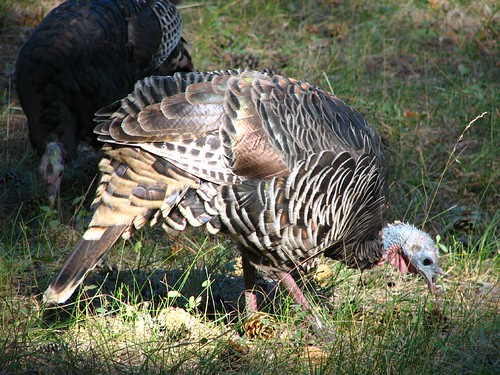 />
/>Wild, wild turkeys
I will ride them
someday
Wild turkeys
Clever, scheming, and perfect for a Thanksgiving feast
(The following was published in the November 2006 issue of Bozeman's Tributary Magazine)
By Ray Sikorski
We all know the story: Ben Franklin wanted the turkey to be the national bird, but the arrogant bald eagle won out.
So the bald eagle flies high and looks tough — big deal! The turkey is humble yet wiley. The turkey is sensitive and alert. And the turkey tastes good.
Which is why we eat ‘em on Thanksgiving. I suppose it wouldn’t really be cool to go the supermarket and pick up a frozen hormone-laden 20 pound bald eagle to roast and eat with giblet gravy; national birds are for looking at and putting on Express Mail packages, not for eating.
Turkeys, on the other hand…
Wouldn’t it be nice, just once, to forsake the insipid store-bought bird and go out and find a real bird — the svelte turkey, who’s out there every day running around, gobbling, struttin’ his stuff? Sure, it may not be as tender and juicy as Butterball’s best, but it would be wild and it would be yours. There, on the dinner table, with the good plates and the fancy silverware. That dead thing in the middle, surrounded by the candied yams — you did that.
Of course, it’s not so simple. Wild turkeys aren’t just standing around, waiting to be shot. Well, sometimes they’re just standing around, but chances are it’s not when you’re toting your shotgun. Turkeys know. They have that sense. Incredible eyesight is part of it; with its side-set eyes, a slight movement of the head is all the turkey needs for 360 degree vision. Some hunters claim wild turkeys can see through rocks, while others sense they merely see around them. The camouflage industry as we know it today exists because of turkey hunters. There’s the patterns — mossy oak, forest floor, hardwoods, pine straw — the camo shotguns, the face paint.
Some wear “more camouflage than a walking tree,” said Greg Byrne of Powderhorn Sporting Goods. Byrne said some hunters go so far as to camouflage their own smell, with oil of pine or something called “Earth Smell.”
But finding the turkey is only part of the game. The rest of it is getting the turkey to come to you. The Powderhorn’s George Dieruf explained that this is what makes turkey hunters some of the most crazed, obsessed hunters out there. It’s not about finding your prey and blowing it to smithereens. It’s about coaxing your prey into coming out of hiding, just for you. Then blowing it to smithereens.
Dieruf said that Montana regulations don’t require hunters of the native Merriam’s turkeys to “call in” their prey, but said the satisfaction gained from seeing a gobbler come towards you over a hill is what died-in-the-wool turkey hunters live for.
Some use decoys to bring in the birds, but no serious turkey hunter goes into the wild without at least a few turkey calls at his or her disposal. The cluck. The putt. The yelp. The cackle. The kee kee. The purr. The entire gamut of the sensitive bird’s emotional states: Content. Excited. Horny as a hound dog. Feeling like sitting on the couch all day and playing sad songs on the stereo. The seasoned turkey hunter knows these moods, and can replicate them using a variety of devices, some of which can be made at home. Turkey wingbones have been used by Native Americans as a “yelper” call for over 4,000 years, and they’re still used today. According to Dieruf, wooden box calls are among the easiest to master. Other calls can be made from turtle shells or pieces of slate; a film canister or prescription pill box with a bit of latex over a hole can make a respectable gobble.
Merriam’s turkeys aren’t found around Bozeman; hunters have to trek as least as far east as Big Timber to find the birds. The good news is that turkey hunting has two seasons, spring and fall, so hunters have something to do when they’re not able to go out after the big game.
Of course, for serious stalkers of the wiley bird, there’s only one prey that matters. Although Dieruf claimed that Montana’s Merriam’s aren’t as skittish as some of its counterparts farther east, some wild turkey hunters are so obsessed that they’ll stalk the same bird — unsuccessfully, apparently — year after year.
This time of year, there’s more at stake than just your pride — there’s Thanksgiving dinner. Sure, the wild bird may be a bit drier than the puffed-up supermarket variety — the wife of one local hunter said she stuffs the birds with fruit to moisten things up — but that’s because it’s busy running around outwitting hunters like you.
And even if you can’t put one on the Thanksgiving table, you’ve got to admit it deserves your respect.
2 comments:
Nice story. But shouldn't 20-pound be hyphenated? I'm just some random person reading this, not a former co-worker!
Ray lets go skin up the 'ol ski hill. It's snowing something fierce outside now. Ross 2/1/07
Post a Comment